Practicing the Intermediate 2nd Year Maths 2A Textbook Solutions Inter 2nd Year Maths 2A Probability Solutions Exercise 9(c) will help students to clear their doubts quickly.
Intermediate 2nd Year Maths 2A Probability Solutions Exercise 9(c)
I.
Question 1.
Three screws are drawn at random from a lot of 50 screws, 5 of which are defective. Find the probability of the event that all 3 screws are non-defective assuming that the drawing is (a) with replacement (b) without replacement.
Solution:
Let S be the sample space
∴ The total number of screws = 50
The number of defective screws is 5 and the remaining 45 screws are non-defective.
Let A be the event of getting a drawing of the 3 screws is non-defective.
(a) With replacement
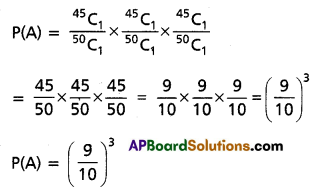
(b) Without replacement

Question 2.
If A, B, C are three independent events of an experiment such that P(A ∩ BC ∩ CC) = \(\frac{1}{4}\), P(AC ∩ B ∩ CC) = \(\frac{1}{8}\), P(AC ∩ BC ∩ CC) = \(\frac{1}{4}\), then find P(A), P(B) and P(C).
Solution:
Since A, B, C are independent events.
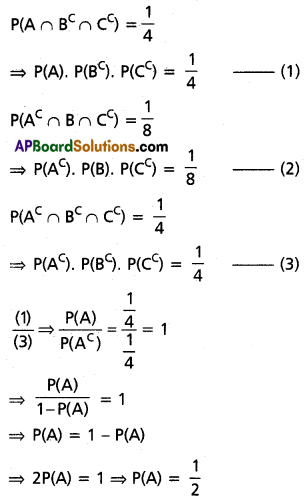
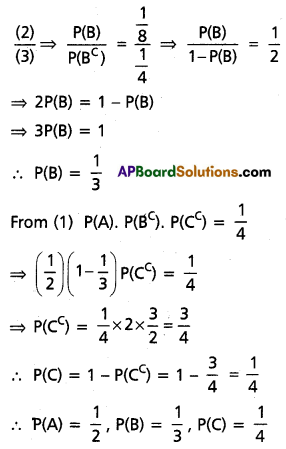
Question 3.
There are 3 black and 4 white balls in one bag. 4 black and 3 white balls in the second bag. A die is rolled and the first bag is selected if it is 1 or 3 and the second bag for the rest. Find the probability of drawing a black ball from the bag thus selected.
Solution:
Probability of selecting first bag = \(\frac{2}{6}=\frac{1}{3}\)
Probability of selecting second bag = 1 – \(\frac{1}{3}\) = \(\frac{2}{3}\)
Probability of getting a black ball from first bag = \(\frac{3}{7}\)
Probability of getting a black ball from the second bag = \(\frac{4}{7}\)
Probability of drawing a black ball = \(\frac{1}{3} \cdot \frac{3}{7}+\frac{2}{3} \cdot \frac{4}{7}\) = \(\frac{11}{21}\)
![]()
Question 4.
A, B, C are aiming to shoot a balloon, A will succeed 4 times out of 5 attempts. The chance of B shooting the balloon is 3 out of 4 and that of C is 2 out of 3. If three aim at the balloon simultaneously, then find the probability that atleast two of them hit the balloon.
Solution:
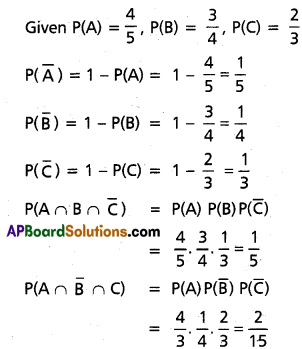
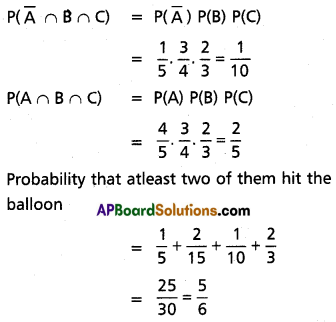
Question 5.
If A, B are two events, then show that \(P\left(\frac{A}{B}\right) P(B)+P\left(\frac{A}{B^C}\right) P\left(B^C\right)=P(A)\)
Solution:

Question 6.
A pair of dice are rolled. What is the probability that they sum to 7, given that neither die shows a 2?
Solution:
Let A be the event that the sum of the two dice is 7, then
A = {(1, 6), (2, 5), (3, 4), (4, 3), (5, 2), (6, 1)}
Let B be the event that neither die shows a 2
B = {(1, 1), (1, 3), (1, 4), (1, 5), (1, 6)
(3, 1), (3, 3), (3, 4), (3, 5), (3, 6)
(4, 1), (4, 3), (4, 4), (4, 5), (4, 6)
(5, 1), (5, 3), (5, 4), (5, 5), (5, 6)
(6, 1), (6, 3), (6, 4), (6, 5), (6, 6)}
n(B) = 25
A ∩ B = {(1, 6), (3, 4), (4, 3), (6, 1)}
n(A ∩ B) = 4
Required probability
\(P\left(\frac{A}{B}\right)=\frac{P(A \cap B)}{P(B)}\)
= \(\frac{n(A \cap B)}{n(B)}\)
= \(\frac{4}{25}\)
Question 7.
A pair of dice are rolled. What is the probability that neither die shows a 2, given that they sum to 7?
Solution:
Let A be the event that the sum on two dice is 7
A = {(1, 6), (2, 5), (3, 4), (4, 3), (5, 2), (6, 1)}
∴ n(A) = 6
Let B be the event that neither die shows a 2
B = {(1, 1), (1, 3), (1, 4), (1, 5), (1, 6)
(3, 1), (3, 3), (3, 4), (3, 5), (3, 6)
(4, 1),(4, 3), (4, 4), (4, 5), (4, 6)
(5, 1), (5, 3), (5, 4), (5, 5), (5, 6)
(6, 1), (6, 3), (6, 4), (6, 5), (6, 6)}
A ∩ B = {(1, 6), (3, 4), (4, 3), (6, 1)}
n(A ∩ B) = 4
Required probability
\(P\left(\frac{B}{A}\right)=\frac{P(A \cap B)}{P(A)}\)
= \(\frac{n(A \cap B)}{n(A)}\)
= \(\frac{4}{6}\)
= \(\frac{2}{3}\)
![]()
Question 8.
If A, B are any two events, in an experiment, and P(B) ≠ 1 Show that \(P\left(\frac{A}{B^C}\right)=\frac{P(A)-P(A \cap B)}{1-P(B)}\)
Hint: P(A ∩ BC) = P(A) – P(A ∩ B)
Solution:
By definition of condition probability
\(P\left(\frac{A}{B^C}\right)=\frac{P\left(A \cap B^C\right)}{P\left(B^C\right)}\)
= \(\frac{P(A)-P(A \cap B)}{1-P(B)}\)
∵ P(BC) = \(P(\bar{B})\) = 1 – P(B)
Question 9.
An urn contains 12 red balls and 12 green balls. Suppose two balls are drawn one after another without replacement. Find the probability that the second ball drawn is green given that the first ball drawn is red.
Solution:
Total number of balls in an urn n(S) = 24
Let E1 be the event of drawing a red ball in the first draw
P(E1) = \(\frac{{ }^{12} C_1}{24}=\frac{1}{2}\)
Now the number of balls remaining is 23
Let \(\frac{E_2}{E_1}\) be the events of drawing a green ball in the second drawn
P(E2/E1) = \(\frac{12}{23}\)
∴ Required probability
P(E1 ∩ E2) = P(E1) . P(E2/E1)
= \(\frac{1}{2} \times \frac{12}{23}\)
= \(\frac{6}{23}\)
∴ The probability of the second ball drawn is green given that the first ball drawn is red = \(\frac{6}{23}\)
Question 10.
A single die is rolled twice in succession. What is the probability that the number showing on the second toss is greater than that on the first rolling?
Solution:
A single die is rolled twice.
Let S be the sample space n(S) = 62 = 36
Let A be the event of getting the required event.
A = {(1, 2), (1, 3), (1, 4), (1, 5), (1, 6), (2, 3), (2, 4), (2, 5), (2, 6), (3, 4), (3, 5), (3, 6), (4, 5), (4, 6), (5, 6)}
n(A) = 15
∴ P(A) = \(\frac{n(A)}{n(S)}\) = \(\frac{15}{36}\) = \(\frac{5}{12}\)
Question 11.
If one card is drawn at random from a pack of cards then show that events of getting an ace and getting a heart are independent events.
Solution:
Suppose A is the event of getting an ace and B is the event of getting a heart.
∴ P(A) = \(\frac{4}{52}=\frac{1}{13}\)
P(B) = \(\frac{13}{52}=\frac{1}{14}\)
A ∩ B is the event of getting a Heart’s ace
P(A ∩ B) = \(\frac{1}{52}=\frac{1}{13} \cdot \frac{1}{4}\) = P(A) . P(B)
∴ A and B are independent events.
Question 12.
The probability that boy A will get a scholarship is 0.9 and that another boy B will get one is 0.8. What is the probability that atleast one of them will get the scholarship?
Solution:
Suppose E1 is the event of a boy ‘A’ getting a scholarship and E2 is the event of another boy B getting the scholarship.
Given P(E1) = 0.9, P(E2) = 0.8
E1 and E2 are independent events.
P(E1 ∩ E2) = P(E1) . P(E2)
= (0.9) (0.8)
= 0.72
The probability that atleast one of them will get a scholarship = P(E1 ∪ E2)
= P(E1) + P(E2) – P(E1 ∩ E2)
= 0.9 + 0.8 – 0.72
= 1.7 – 0.72
= 0.98
![]()
Question 13.
If A, B are two events with P(A ∪ B) = 0.65 and P(A ∩ B) = 0.15, then find the value of P(AC) + P(BC).
Solution:
By addition theorem on probability
P(A ∪ B) = P(A) + P(B) – P(A ∩ B)
P(A) + P(B) = P(A ∪ B) + P(A ∩ B)
= 0.65 + 0.15
= 0.8
P(A) + P(B) = 0.8 ……..(1)
P(AC) = 1 – P(A) + 1 – P(B)
= 2 – [P(A) + P(B)]
= 2 – 0.8 [∵ by (1)]
= 1.2
Question 14.
If A, B, C are independent events, show that A ∪ B, and C are also independent events.
Solution:
∵ A, B, C are independent events.
⇒ A, B; B, C; C , A are also independent events
P(A ∩ B ∩ C) = P(A) P(B) P(C)
P(A ∩ C) = P(A) . P(C)
P(B ∩ C) = P(B) . P(C)
P(A ∩ B) = P(A) . P(B)
P[(A ∪ B) ∩ C] = P[(A ∩ C) ∪ (B ∩ C)]
= P(A ∩ C) + P(B ∩ C) – P[(A ∩ C) ∩ (B ∩ C)]
= P(A) . P(C) + P(B) . P(C) – P(A ∩ B ∩ C)
= P (A) . P(C) + P(B) . P(C) – P(A) . P(B) . P(C)
= [P(A) + P(B) – P(A) . P(B)] P(C)
= P(A ∪ B) . P(C)
∴ A ∪ B and C are independent events.
Question 15.
A and B are two independent events such that the probability of both the events occurring is \(\frac{1}{6}\) and the probability of both the events do not occur is \(\frac{1}{3}\). Find the probability of A.
Solution:
A and B are independent events.


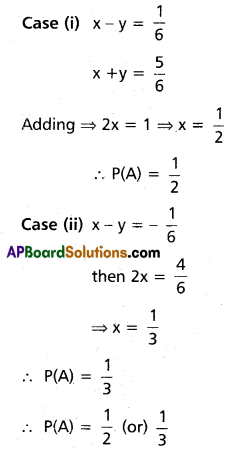
Question 16.
A fair die is rolled. Consider the events. A = {1, 3, 5}, B = {2, 3} and C = {2, 3, 4, 5}. Find
(i) P(A ∩ B), P(A ∪ B)
(ii) P(\(\frac{A}{B}\)), P(\(\frac{B}{A}\))
(iii) P(\(\frac{A}{C}\)), P(\(\frac{C}{A}\))
(iv) P(\(\frac{B}{C}\)), P(\(\frac{C}{B}\))
Solution:
A fair die is rolled
P(A) = \(\frac{3}{6}=\frac{1}{2}\)
P(B) = \(\frac{2}{6}=\frac{1}{3}\)
P(C) = \(\frac{4}{6}=\frac{2}{3}\)
n(S) = 61 = 6
Given A = {1, 3, 5}, B = {2, 3}, C = {2, 3, 4, 5}
(i) A ∩ B = {3}
P(A ∩ B) = P{3} = \(\frac{1}{6}\)
∴ P(A ∩ B) = \(\frac{1}{6}\)
(A ∪ B) = {1, 2, 3, 5}
n(A ∪ B) = 4
n(S) = 6
P(A ∪ B) = \(\frac{4}{6}=\frac{2}{3}\)
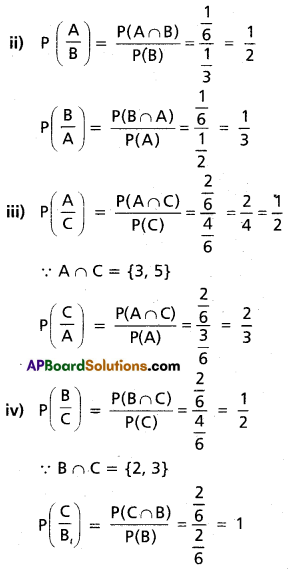
![]()
Question 17.
If A, B, C are three events in a random experiment, prove the following:
(i) P(\(\frac{A}{A}\)) = 1
Solution:
\(P\left(\frac{A}{A}\right)=\frac{P(A \cap A)}{P(A)}=\frac{P(A)}{P(A)}=1\)
(ii) \(\mathbf{p}\left(\frac{\phi}{A}\right)=0\)
Solution:
\(P\left(\frac{\phi}{A}\right)=\frac{P(\phi \cap A)}{P(A)}=\frac{0}{P(A)}=0\)
(iii) A ⊂ B ⇒ P(\(\frac{A}{C}\)) ≤ P(\(\frac{B}{C}\))
Solution:

(iv) P(A – B) = P(A) – P(A ∩ B)
Solution:
A – B = {x / x ∈ A a x ∉ B}
A – B = A – (A ∩ B)
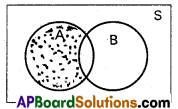
P(A – B) = P[A – (A ∩ B)] = P(A) – P(A ∩ B)
(v) If A, B are mutually exclusive and P(B) > 0, then P(\(\frac{A}{B}\)) = 0.
Solution:
We know \(P\left(\frac{A}{B}\right)=\frac{P(A \cap B)}{P(B)}\)
= \(\frac{0}{\mathrm{P}(\mathrm{B})}\)
= 0 [∵ A, B are mutually exclusive events]
Hint: A, B are mutually exclusive then A ∩ B = φ ⇒ P(A ∩ B) = 0.
(vi) If A, B are mutually exclusive then P(A/BC) = \(\frac{\mathrm{P}(\mathrm{A})}{1-\mathrm{P}(\mathrm{B})}\); when P(B) ≠ 1.
Solution:
Given P(A ∩ B) = 0 (∵ A and B are mutually exchanging)
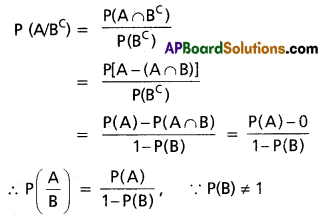
(vii) If A, B are mutually exclusive and P(A ∪ B) ≠ 0, then \(P\left(\frac{A}{A \cup B}\right)=\frac{P(A)}{P(A)+P(B)}\)
Solution:
Hint: A ∩ (B ∪ C) = (A ∩ B) ∪ (A ∩ C)
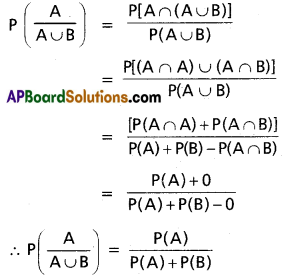
Question 18.
Suppose that a coin is tossed three times. Let A be “getting three heads” and B be the event of “getting a head on the first toss”. Show that A and B are dependent events.
Solution:
Let event A be “getting their heads”, and B be the event of “getting a head on the first toss” when a coin is tossed three times.
∴ A = {HHH}
n(A) = 1
P(A) = \(\frac{1}{8}\)
B = {HTT, HTH, HHT, HHH}
n(B) = 4
P(B) = \(\frac{4}{8}\)
A ∩ B = {HHH}
n(A ∩ B) = 1
P(A ∩ B) = \(\frac{1}{8}\)
P(A) . P(B) = \(\frac{1}{8} \cdot \frac{4}{8}=\frac{1}{16}\) ≠ P(A ∩ B)
∴ P(A ∩ B) ≠ P(A) . P(B)
Hence A, B are dependent events.
Question 19.
Suppose that an unbiased pair of dice is rolled. Let A denote the event that the same number shows on each die. Let B denote the event that the sum is greater than 7. Find (i) P(\(\frac{A}{B}\)) (ii) P(\(\frac{B}{A}\))
Solution:
Given a denote the event that the same number on pair of dice is rolled.
A = {(1, 1), (2, 2), (3, 3), (4, 4), (5, 5) (6, 6)}
n(A) = 6
P(A) = \(\frac{6}{36}=\frac{1}{6}\)
Given B denote the event that the sum is greater than 7 when pair of dice is rolled.
∴ B = {(2, 6), (3, 5), (4, 4), (5, 3), (6, 2), (3, 6), (4, 5), (5, 4), (6, 3), (4, 6), (5, 5), (6, 4), (5, 6), (6, 5), (6, 6)}
∴ n(B) = 15
P(B) = \(\frac{15}{36}\)
A ∩ B = {(4, 4), (5, 5), (6, 6)}
n(A ∩ B) = 3
P(A ∩ B) = \(\frac{3}{36}\)
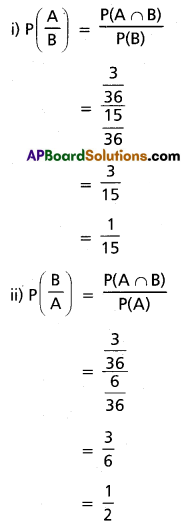
Question 20.
Prove that A and B are independent events if and only if \(P\left(\frac{A}{B}\right)=P\left(\frac{A}{B^C}\right)\)
Solution:
Let A and B be independent

⇒ \(\frac{P(A \cap B)}{P(B)}=\frac{P(A)-P(A \cap B)}{1-P(B)}\)
⇒ P(A ∩ B) – P(B) P(A ∩ B) = P(A) P(B) – P(B) . P(A ∩ B)
⇒ P(A ∩ B) = P(A) . P(B)
∴ A, B are independent.
Hence, A, B are independent iff
\(P\left(\frac{A}{B}\right)=P\left(\frac{A}{B^C}\right)\)
![]()
II.
Question 1.
Suppose A and B are independent events with P(A) = 0.6, P(B) = 0.7 then compute
(i) P(A ∩ B)
(ii) P(A ∪ B)
(iii) P(\(\frac{B}{A}\))
(iv) P(AC ∩ BC)
Solution:
Given A, B are independent events and
P(A) = 0.6, P(B) = 0.7
(i) P(A ∩ B) = P(A) . P(B)
= 0.6 × 0.7
= 0.42
(ii) P(A ∪ B) = P(A) + P(B) – P(A ∩ B)
= 0.6 + 0.7 – 0.42
= 1.3 – 0.42
= 0.88
(iii) P(\(\frac{B}{A}\)) = P(B) = 0.7
(iv) P(AC ∩ BC) = P(AC) . P(BC) (∵ AC & BC are also independent events)
= [1 – P(A)] [1 – P(B)]
= (1 – 0.6) (1 – 0.7)
= 0.4 × 0.3
= 0.12
Question 2.
The probability that Australia wins a match against India in a cricket game is given to be \(\frac{1}{3}\). If India and Australia play 3 matches, what is the probability that,
(i) Australia will lose all three matches?
(ii) Australia will win atleast one match?
Solution:
Suppose A is the event of Australia winning the match.
Given P(A) = \(\frac{1}{3}\)
∴ P(\(\overline{\mathrm{A}}\)) = 1 – P(A)
= 1 – \(\frac{1}{3}\)
= \(\frac{2}{3}\)
(i) Probability that Australia will loose all the three matches = P(\(\overline{\mathrm{A}}\))3
= \(\left(\frac{2}{3}\right)^3\)
= \(\frac{8}{27}\)
(ii) Probability that Australia will win atleast one match = 1 – P(\(\overline{\mathrm{A}}\))3
= 1 – \(\frac{8}{27}\)
= \(\frac{19}{27}\)
Question 3.
Three boxes numbered I, II, III contain balls as follows:
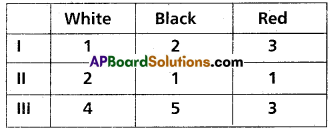
One box is randomly selected and a ball is drawn from it. If the ball is red, then find the probability that it is from box II.
Solution:
Let B1, B2, B3 be the events of selecting the Ist, IInd and IIIrd boxes respectively.
Then P(B1) = P(B2) = P(B3) = \(\frac{1}{3}\)
Probability of selecting a red ball from the first box = \(\frac{3}{6}\) = P(R/B1)
Probability of selecting a red ball from the second box = \(\frac{1}{4}\) = P(R/B2)
Probability of selecting a red ball from the third box = \(\frac{3}{12}\) = P(R/B3)
Assuming that the ball is red, the probability it is from box II,
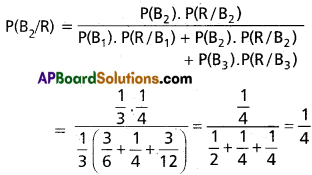
Question 4.
A person secures a job in a construction company in which the probability that the workers go on strike is 0.65 and the probability that the construction job will be completed on time if there is no strike is 0.80. If the probability that the construction job will be completed on time even if there is a strike is 0.32, determine the probability that the constructed job will be completed on time.
Solution:
Let P(S) = Probability of the workers going on strike = 0.65
P(\(\bar{S}\)) = Probability on the workers go on strike
= 1 – P(S)
= 1 – 0.65
= 0.35
\(P\left(\frac{E}{S}\right)\) = Probability that the job completed if there is no strike = 0.32
\(\mathrm{P}\left(\frac{\mathrm{E}}{\overline{\mathrm{S}}}\right)\) = Probability that the job completed if there is a strike = 0.80
P(E) = Probability that the construction job will be completed on time
= P(S) \(P\left(\frac{E}{S}\right)\) + P(\(\bar{S}\)) \(\mathrm{P}\left(\frac{\mathrm{E}}{\overline{\mathrm{S}}}\right)\)
= (0.65) (0.32) + (0.35) (0.08)
= 0.2080 + 0.2800
= 0.4880
![]()
Question 5.
For any two events A, B show that
P(A ∩ B) – P(A) P(B) = P(AC) P(B) – P(AC ∩ B) = P(A) P(BC) – P(A ∩ BC)
Solution:
R.H.S. I = P(AC) P(B) – P(AC ∩ B)
= [(1 – P(A)] P(B) – [P(B) – P(A ∩ B)]
= P(B) – P(A) P(B) – P(B) + P(A ∩ B)
= P(A ∩ B) – P(A) P(B)
= L.H.S
R.H.S. II = P(A) P(BC) – P(A ∩ BC)
= P(A) [1 – P[P(B)] – [P(A) – P(A ∩ B)]
= P(A) – P(A) P(B) – P(A) + P(A ∩ B)
= P(A ∩ B) – P(A) P(B)
= L.H.S
∴ L.H.S = R.H.S I = R.H.S II
Hence P(A ∩ B) – P(A) . P(B) = P(AC) P(B) – P(AC ∩ B) = P(A) P(BC) – P(A ∩ BC)
III.
Question 1.
Three Urns have the following composition of balls.
Urn I: 1 White, 2 black
Urn II: 2 White, 1 black
Urn III: 2 White, 2 balck
One of the Urn is selected at random and a ball is drawn. It turns out to be white. Find the probability that it comes from Urn III.
Solution:
Let Ei be the event of Choosing the Urn i = 1, 2, 3, and P(Ei) be the probability of choosing the Urn i = 1, 2, 3
Then P(E1) = P(E2) = P(E3) = \(\frac{1}{3}\)
Having choosen the Urn i, the probability of drawing a white ball, P(W/Ei), is given by
P(W/E1) = \(\frac{1}{3}\)
P(W/E2) = \(\frac{2}{3}\)
P(W/E3) = \(\frac{2}{4}\)
We have to find the probability P(E3/W) by Baye’s theorem.

Question 2.
In a shooting test the probability of A, B, C hitting the targets are \(\frac{1}{2}\), \(\frac{2}{3}\) and \(\frac{3}{4}\) respectively. If all of their fire is at the same target. Find the probability that
(i) Only one of them hits the target
(ii) At atleast one of them hits the target
Solution:
The probabilities that A, B, C hit the targets are denoted by

Question 3.
In a certain college, 25% of the boys and 10% of the girls are studying mathematics. The girls constitute 60% of the student’s strength. If a student selected at random is found studying mathematics. Find the probability that the student is a girl.
Solution:
The probability that a student selected to be a girl
P(G) = \(\frac{60}{100}=\frac{6}{10}\)
The probability that a student selected to be a boy
P(B) = \(\frac{40}{100}=\frac{4}{10}\)
The probability that a boy studying mathematics
P(M/B) = \(\frac{25}{100}=\frac{1}{4}\)
Similarly probability that a girl studying mathematics
P(M/G) = \(\frac{10}{100}=\frac{1}{10}\)
We have to find P(G/M) By Baye’s theorem

![]()
Question 4.
A person is known to speak the truth 2 out of 3 times. He throws a die and reports that it is 1. Find the probability that it is actually 1.
Solution:
P(T) = Probability that a person speaks truth 2 out of 3 times = \(\frac{2}{3}\)
P(F) = 1 – P(T)
= 1 – \(\frac{2}{3}\)
= \(\frac{1}{3}\)
After he reports that it is 1, it is true if it actually shows 1 otherwise false if does not show 1.
P(1) = \(\frac{1}{6}\) and P(T) = \(\frac{5}{6}\)
P(T/1) = P(reports true if it is 1) = \(\frac{2}{3}\)
P(F/T) = P(report False if it is T) = \(\frac{1}{3}\)
By Baye’s theorem
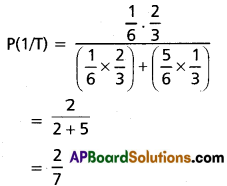
∴ The probability that reports that it is 1 and actually it is 1 is \(\frac{2}{7}\).